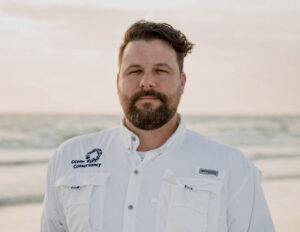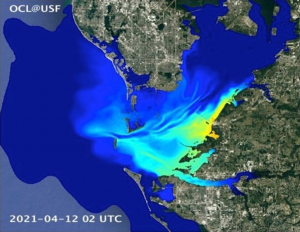By Jon Paul “J.P.” Brooker, Director of Florida Conservation for Ocean Conservancy
While the Piney Point disaster seems to no longer pose an immediate threat to human lives, the ecological disaster may just be unfolding.
Catastrophically, the spill of over 200 million gallons of toxic, nutrient rich phosphate mining wastewater into Tampa Bay and the Gulf of Mexico threatens Florida’s iconic marine environment.

Florida is a state whose economic, cultural, and recreational identity is inextricably interwoven with the health of its coasts – the Piney Point spill puts that Floridian way of life at risk. Ocean Conservancy is working with scientists to enhance monitoring of the spill from Piney Point in a formal partnership with the University of Florida’s Center for Coastal Solutions. This is important research that needs to be done to supplement the conventional water quality monitoring being done by the FDEP.
But Piney Point is just the latest, most severe example of a litany of threats to Florida’s environment that are all linked to the same overarching problem: In Florida, we are at an environmental crossroads.
Without an all-hands-on-deck approach that brings Floridians from all walks of life and across the political spectrum into a unified approach, the Floridian environment and the economy that is driven by a healthy ocean and coastal environment may be lost.
Perhaps the most harrowing thing about this litany of threats is that they are all going to get dramatically worse with a changing climate.
Global warming will bring warmer ocean temperatures, which is like pouring gasoline on a Tropical Weather fire. Hurricanes and severe weather will become more frequent and more disastrous and will threaten more breaches of phosphogypsum stacks including Piney Point.

More frequent and severe hurricanes also will pick up and spread harmful algal blooms, such as red tide, across regions from Southwest Florida to the Panhandle. Warmer water provides optimal conditions for algal bloom growth.
Heavy rainfall or hurricanes or a simple lack of oversight will generate more dispersals of nutrient rich water. Spills like Piney Point will fuel algal blooms, spur fish kills, wreak havoc on marine mammals, spoil our beaches, and threaten our economy.
A changing climate also portends sea levels rising, which will further affect infrastructure and jeopardize our ability to deal with the threats like Piney Point.
It’s all interrelated. All of these problems can fuel one another, and be exacerbated by one another.
This is why we desperately need a unified approach to the most existential threat that is staring us down: Ensuring Floridian resilience in the face of a dramatically changing climate.
The state is taking a step in the right direction by putting up money to figure out how to deal with Piney Point – but that’s merely the baseline response needed. There are 25 similar phosphogypsum stacks in Florida, some of which are also on Tampa Bay, and any time we get a heavy rain we run the risk of spilling toxic, nutrient rich, radioactive wastewater into the Gulf of Mexico.
Piney Point and phosphogypsum stacks are just one piece of the broader resilience puzzle. We need visionary leadership and a cohesive, meaningful response to the Floridian resilience problem.
Jon Paul “J.P.” Brooker is the director of Florida Conservation and attorney for Ocean Conservancy.
“The Invading Sea” is the opinion arm of the Florida Climate Reporting Network, a collaborative of news organizations across the state focusing on the threats posed by the warming climate.



